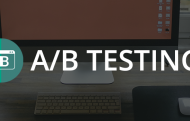
CRO Best Practices: A/B Testing part 2
You can find the first 3 articles of our series on CRO Best Practices here, here and here.
In this fourth and last article, we finish our overview of A/B Testing best practices.
5. Understand your visitors better
Conduct an analytical and ergonomic audit to understand your users better, especially those who do not convert.
Traffic sources and navigation
What are your main traffic sources? How do your visitors navigate your website? Which pages do they reach? How do they behave? What is their usual navigation path? Do you identify pages with strong bounce rates or funnel steps with a high exit rate?
With an analytical audit, you can determine ways to optimize your website.
User experience
Shopping cart abandonments are often linked to navigation problems your users encountered: loading time, error messages, complex forms, lack (or overload) of information …
A number of behavioral analysis tools can help you ascertain these problems: mouse testing, form analysis, click, scroll and heat maps.
An ergonomic audit will help you delve into the analytical results to spot good trends and make the right decisions.
Objections & complaints
Always try to identify why users fail to convert. It is indeed much more difficult to obtain customers objections on the web than in actual stores.
But with surveys or questionnaires (for example Google forms, Qualaroo, …) you can easily get qualitative data on your visitors. Let’s not forget about forums and social medias, both excellent sources of objections or complaints.
Once you identify recurring pain points, you can set up tests to correct them.
6. Reassure your customers and prospects
What if you had highly persuasive and differentiating strengths other than your competitive advantages?
Customers or prospects always need to be reassured and comforted in their choices.
The key is to identify turning points in their buying journey, then providing them with social proof and reassurance.
Some examples would be customer testimonials, case studies, mentions in the media, or achievements.
You most likely already have the materials, you just need to create the content and determine where to put it for maximum effect.
7. Set up your test roadmap
a. Set your KPIs
Each test has goals, primary and secondary KPIs to follow. You absolutely MUST define each of them and see if you can accurately monitor them.
b. Prioritize your tests
With all those analysis, you should have a whole slew of test ideas. Now you need to prioritize. That way you can close potential blind spots, earn conversion points and not get into a testing spree that could damage your results.
You can use the answers to these 3 questions for each test to prioritize:
-
- What are the odds of doubling your conversion rate?
- How easily could you set up this test?
With simple tests, you‘ll save development time, see results quickly and build confidence. You can then switch to more advanced tests smoothly.
-
- Has this idea ever worked before?
Once you’re testing consistently, you’ll quickly see what your visitors react to. Careful monitoring will allow you to enter a virtuous logic and build on new ideas inspired by successful tests.
Considering how quickly users behavior evolves, you can also repeat tests that were not relevant before, so keep a backlog of your tests (successful or not).
c. Design your variations
Now that you went through these 7 steps, you can create the content you want to test.
First, create a wireframe (zoning) of the new page or element. You can use software like Balsamiq or Moqups to do so.
Be mindful of key content like headlines, CTA or introductions. Then conduct usability tests with the help of anyone with an empathetic understanding of your customers.
Once adjustments are made, you can mock up the variation with a web designer.
d. Communicate
Before launching the test, make sure you distribute to your team (or everyone if you feel like it) a document with the following items:
- Why are you conducting this test?
- How will you quantify success (KPIs to follow)?
- How does this test align to your business objectives?
- How will this test be integrated on your website?
Similarly, once your test is complete, communicate on the results.
We strongly suggest you keep those documents to keep track of the evolutions on your website and feed your next test ideas.
e. Pay VERY close attention to the duration and significance
If you want real results—not false positives, wait till you reach a certain traffic and number of conversions (we recommend you wait till you have 500 conversions per variation) before stopping the test.
No need to try and draw conclusions before the end of the test. Actually, you can’t. You can’t possibly know what results will look like. That’s why you’re testing, so make sure you do it right, or don’t test at all, your choice.
This may sound a bit abrupt, but hear us out. Why go through the trouble of testing, if you stop before your results have any real value whatsoever? It’s a loss of time and money.
A/B Testing takes time and traffic, but it really pays out if done correctly.
Only when you reach statistical significance—and only then, you can analyze your results and say which variations won (if any).
8. Transfer your winning campaigns to other channels
By diversifying your acquisition strategies, you secure your business model. An increased conversion rate allows you to permanently increase your investments in other channels, such as SEO, PPC, social media, affiliate and offline media.
Moreover, you can think about how to integrate the findings of your winning tests in other parts of your funnel, for example:
- A winning hook from a tested landing page can provide a new title for an Adwords campaign (or vice versa)
- A winning landing page can be a template for a printed ad
- The wording of a winning offer on your own supports can be used for affiliation
9. Repeat!
The A/B Testing methodology is iterative: your next tests will be based on the results of past tests. Don’t abandon ideas because it failed once, there could be a number of reasons why it did. So keep testing!
With every increase in your conversion rate, you leave your competition a little more behind. And with every test, more optimization opportunities arise.
This is exactly why after each test, it’s important you take a step back and look again at your entire conversion funnel to identify where you should focus your efforts now.
Done effectively, with a deliberate process, A/B Testing will sustainably boost the growth of your business.
So let’s get testing!


